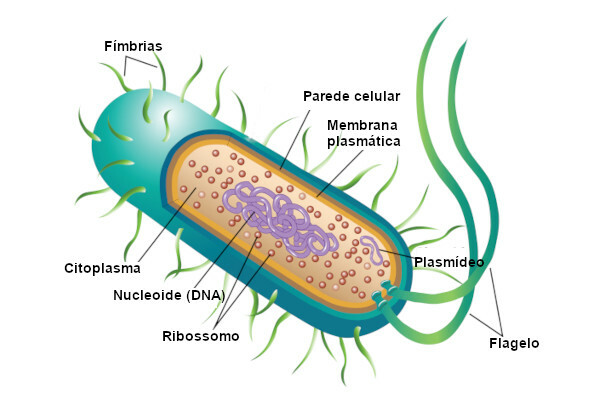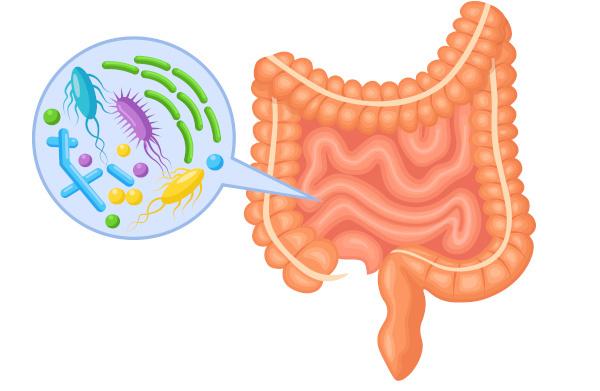Bacteria they are unicellular organisms that do not have a defined nucleus or membranous organelles. They can be classified according to their shape, with the most common shapes being spherical, stick and spiral. Well known for causing disease in human beings, bacteria are also important, acting, for example, in the decomposition of organic matter and being used in the manufacture of food, such as yogurts.
the bacteria initially were grouped in the Kingdom Monera, in which all prokaryotes were included. With the classification of living beings into three domains, the Monera Kingdom ceased to exist. The prokaryotic organisms, then, are divided into two groups: the domain archaea and the domain Bacterium.
Read too: Three domains — the division of living things that is based on evolutionary aspects
General characteristics of bacteria
Bacteria are organisms formed by a single cell (unicellular) and can occur isolated or forming clusters. It is also worth mentioning that bacterial cells are smaller than eukaryotic cells. While bacteria normally have a diameter between 1 µm and 5 µm, eukaryotic cells have a diameter between 10 µm and 100 µm.

bacteria are beings prokaryotes, that is, they do not have a defined nucleus, and their genetic material is concentrated in a region that is not surrounded by a membrane. This region is called the nucleoid. in addition to the genetic material present in the nucleoid, in bacteria can be observed small circular DNA molecules - called plasmids - which replicate independently.
In bacterial cells, the cell organelles, membrane-enclosed structures that are found suspended in the cytosol of eukaryotic cells. Ribosomes are present in this cell type, however, are different from those observed in eukaryotic cells, being smaller and with differences in protein and RNA content.
Do not stop now... There's more after the advertising ;)
bacterial cells are endowed with a cell wall, a structure located outside the plasma membrane. The function of the cell wall is to ensure the maintenance of the shape of the cell and protect her.
To move, many species of bacteria they have scourges. These structures can occur across the entire surface of the cell or be concentrated at the edges. the bacteria can also present the callss fimbriae, which are filamentous structures, similar to hairs, used by these organisms to adhere to the substrate.
Another appendage found in bacteria is the pili, which are structures that hold cells together during DNA transfer. Some authors bring pili and fimbria as synonyms, indicating how sexual pili the appendices related to the transfer of genetic material.
Read too: Differences between prokaryotic and eukaryotic cells
Gram-positive and gram-negative bacteria
A technique called Gram stain allows for the classification of bacteria into two groups, through the analysis of differences in the composition of the cell wall. When subjected to Gram stain, the cell wall of bacteria can take on a violet or red color. Violet-stained bacteria are called gram positive and are characterized by presenting a simpler cell wall and rich in peptidoglycan. the bacteria gram negative, in turn, stain red and have a more complex structure, with less peptidoglycan.
Determining whether a bacterium is gram-positive or gram-negative is important to indicate, for example, what treatment should be adopted in case of infections. Gram-negative bacteria, for example, are generally more resistant to antibiotics than gram-positive ones.
Classification of bacteria
At bacteria are classified in different ways, one of them being the shape of its cells.

- Coconuts: bacteria that are spherical in shape. They can occur singly or in clusters. When they occur in pairs, they are called diplococci; when they form a chain, they are called streptococci; when they group together like a bunch of grapes, they are called staphylococci.
- Bacillus: bacteria that are rod-shaped. They can occur singly, in pairs (diplobacilli) or in chains (streptobacilli).
- Spirils: helical-shaped and rigid bacteria.
- Spirochetes: helical-shaped and flexible bacteria.
- Vibrio: comma-shaped bacteria.
Bacteria reproduction
most bacteria reproduces per binary division, an asexual process in which a bacterium splits in two. Daughter cells are genetically alike, being called clones. The process is relatively fast and, under the right conditions, some species are able to give rise to a new generation in just 20 minutes.

Bacteria can carry out genetic recombination processes, which promote genetic variability. Genetic recombination can occur through three processes.
- Conjugation: two bacteria unite, and one bacterium donates DNA to another.
- Transformation: Bacteria incorporate DNA fragments that are free in the medium.
- transduction: bacteriophages (viruses that infect bacteria) carry genes from one bacterium to another.
Read too: The danger of superbugs — bacteria that are highly resistant to antibiotics
Importance of Bacteria
Bacteria, unlike what many people think, are not only responsible for causing harm to human beings, there are many species important for our health. In our intestine, for example, there are several species of bacteria, which are essential to ensure the normal functioning of the organ. Our intestinal microbiota helps in the absorption of nutrients, produces vitamins and helps to prevent the proliferation of pathogens.

Economically, bacteria are important, for example, because they are used in the manufacture of vinegar and yogurt. We can't forget about the botulinum toxin, produced by the species Clostridium botulinum. This toxin is widely used to smooth out wrinkles and expression lines. Some antibiotics are also produced by bacteria.
At bacteria also have ecological importance, acting, for example, in the decomposition of organic matter, together with fungi. Bacteria also participate in the nitrogen cycle.
Read too: Necrotizing fasciitis: the disease of meat-eating bacteria
Diseases caused by bacteria
There are several bacterial diseases, some of which are extremely serious, and may even lead to death. These diseases are treated with drugs called antibiotics. Below are examples of some illnesses caused by bacteria.
- Syphilis
- Cholera
- leprosy
- Tuberculosis
- Diphtheria
- Tetanus
- Whooping cough
- Pneumonia bacterial
- Meningitis
By Vanessa Sardinha dos Santos
Biology teacher
Bacteria are living things that are most often associated with disease and decomposition of organic matter such as food. However, we know that they are also useful to humans. Regarding the structure of these beings, mark the alternative that NO indicates a feature present in bacteria.
We know that bacteria have a wide variety of forms and ways of life, with some living alone and others forming colonies. We can classify bacteria according to their shape and grouping. Check the alternative that contains only forms of bacteria.

